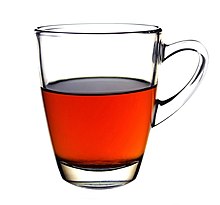
Back شاي أحمر Arabic ৰঙা চাহ Assamese Té negro AST Qara çay Azerbaijani Ҡара сәй Bashkir Чорны чай Byelorussian Черен чай Bulgarian কালো চা Bengali/Bangla ཇ་དམར། Tibetan Te negre Catalan
 A cup of black tea | |
| Type | Tea |
|---|---|
| Country of origin | China[1]: 4 |
| Region of origin | East Asia |
| Colour | Red as brewed beverage |
| Ingredients | Tea leaves |
| Related products | Tea |
| Black tea | |||||||||||||||||||||||||
|---|---|---|---|---|---|---|---|---|---|---|---|---|---|---|---|---|---|---|---|---|---|---|---|---|---|
| Traditional Chinese | 紅茶 | ||||||||||||||||||||||||
| Simplified Chinese | 红茶 | ||||||||||||||||||||||||
| Literal meaning | Red tea | ||||||||||||||||||||||||
| |||||||||||||||||||||||||
Black tea (also literally translated as red tea from various East Asian languages) is a type of tea that is more oxidized than oolong, yellow, white, and green teas. Black tea is generally stronger in flavour than other teas. All five types are made from leaves of the shrub (or small tree) Camellia sinensis, though Camellia taliensis is also rarely used.[2]
Two principal varieties of the species are used – the small-leaved Chinese variety plant (C. sinensis var. sinensis), used for most other types of teas, and the large-leaved Assamese plant (C. sinensis var. assamica), which was traditionally mainly used for black tea, although in recent years some green and white teas have been produced.
First originating in China, the beverage's name there is hong cha (Chinese: 紅茶, "red tea") due to the colour of the oxidized leaves when processed appropriately.[1]: 127 Today, the drink is widespread throughout East and Southeast Asia, both in consumption and harvesting, including in China, Japan, Korea, and Singapore.[3] Similar variants are also available in South Asian countries.
While green tea usually loses its flavour within a year, black tea retains its flavour for several years. For this reason, it has long been an article of trade, and compressed bricks of black tea even served as a form of de facto currency in Mongolia, Tibet, and Siberia well into the 19th century.[4]
- ^ a b Cite error: The named reference
Heiss 2007was invoked but never defined (see the help page). - ^ Liu et al. (2012)[full citation needed]
- ^ Nanien, Yuniar; Aria, Cindyara; Sri, Haryati (14 November 2019). "Important to learn about Indonesian tea diversity: Expert". en.antaranews.com. Antara News. Retrieved 15 October 2021.
- ^ Bressett, Ken. "Tea Money of China". International Primitive Money Society Newsletter (44, August 2001).